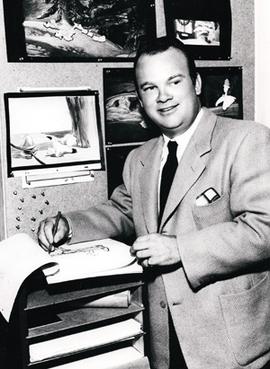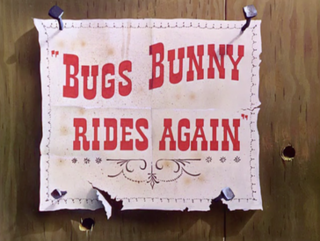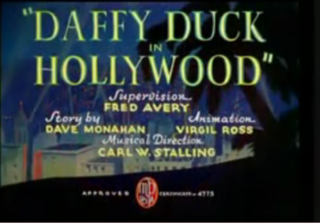Related Research Articles

Daffy Duck is a fictional character created by animators Tex Avery and Bob Clampett for Leon Schlesinger Productions. Styled as an anthropomorphic black duck, he has appeared in cartoon series such as Looney Tunes and Merrie Melodies, in which he is usually depicted as a foil for either Bugs Bunny, Porky Pig or Speedy Gonzales. He was one of the first of the new "screwball" characters that emerged in the late 1930s to replace traditional everyman characters who were more popular earlier in the decade, such as Mickey Mouse, Porky Pig, and Popeye.

Frederick Bean "Tex" Avery was an American animator, cartoonist, director, and voice actor. He was known for directing and producing animated cartoons during the golden age of American animation. His most significant work was for the Warner Bros. and Metro-Goldwyn-Mayer studios, where he was crucial in the creation and evolution of famous animated characters such as Bugs Bunny, Daffy Duck, Porky Pig, Elmer Fudd, Droopy, Screwy Squirrel, The Wolf, Red Hot Riding Hood, and George and Junior.

Porky in Wackyland is a 1938 Warner Bros. Looney Tunes animated short film, directed by Bob Clampett. The short was released on September 24, 1938, and stars Porky Pig venturing out to find the last do-do bird, which he finds in Wackyland, a land that makes no sense located in Darkest Africa.

Merrie Melodies is an American animated comedy short film series distributed by Warner Bros. Pictures. It is the companion series to Looney Tunes, and featured many of the same characters as the former series. It originally ran from August 2, 1931, to September 20, 1969, during the golden age of American animation, though it had been revived in 1979, with new shorts sporadically released until June 13, 1997. Originally, Merrie Melodies placed emphasis on one-shot color films in comparison to the black and white Looney Tunes films. After Bugs Bunny became the breakout character of Merrie Melodies and Looney Tunes transitioned to color production in the early 1940s, the two series gradually lost their distinctions and shorts were assigned to each series randomly.
Warner Bros. Cartoons, Inc. was an American animation studio, serving as the in-house animation division of Warner Bros. during the Golden Age of American animation. One of the most successful animation studios in American media history, it was primarily responsible for the Looney Tunes and Merrie Melodies series of animated short films. The characters featured in these cartoons, including Bugs Bunny, Daffy Duck, and Porky Pig, are among the most famous and recognizable characters in the world. Many of the creative staff members at the studio, including directors and animators such as Chuck Jones, Friz Freleng, Robert McKimson, Tex Avery, Robert Clampett, Arthur Davis, and Frank Tashlin, are considered major figures in the art and history of traditional animation.

The Heckling Hare is a Merrie Melodies cartoon, released on July 5, 1941, and featuring Bugs Bunny and a dopey dog named Willoughby. The cartoon was directed by Tex Avery, written by Michael Maltese, animated by soon-to-be director Robert McKimson, and with musical direction by Carl W. Stalling. In a style that was becoming typical of the Bugs character, he easily outwitted and tormented his antagonist through the short, his only concern being what to do next to the dog.

Elmer's Candid Camera is a 1940 Warner Bros. Merrie Melodies cartoon short directed by Chuck Jones. The short was released on March 2, 1940, and features Elmer Fudd and an early Bugs Bunny prototype.

Bugs Bunny Rides Again is a 1948 Merrie Melodies animated short directed by Friz Freleng. The short was released on June 12, 1948, and stars Bugs Bunny and Yosemite Sam.

Daffy Duck & Egghead is a 1938 Warner Bros. Merrie Melodies cartoon produced in 1937 and directed by Tex Avery. The cartoon was released on January 1, 1938, and stars Daffy Duck and Egghead.

Little Red Walking Hood is a 1937 Merrie Melodies cartoon supervised by Fred Avery. The short was released on November 6, 1937, and features the first appearance of an early character who later became Elmer Fudd.

The Golden Age of Looney Tunes is a collection of LaserDiscs released by MGM/UA Home Video in the 1990s. There were five sets made, featuring a number of discs, and each disc side represented a different theme, being made up of seven cartoons per side. The first volume was also released on VHS, with each tape representing one disc side.
A Feud There Was is a 1938 Warner Bros. Merrie Melodies cartoon directed by Tex Avery. The short was released on September 24, 1938, and features the fourth appearance of an early version of Elmer Fudd.

Elmer J. Fudd is an animated cartoon character in the Warner Bros. Looney Tunes/Merrie Melodies series and the archenemy of Bugs Bunny. His aim is to hunt Bugs, but he usually ends up seriously injuring himself and other antagonizing characters. He speaks in an unusual way, replacing his Rs and Ls with Ws, so he often refers to Bugs Bunny as a "scwewy" or "wascawwy (rascally) wabbit". Elmer's signature catchphrase is, "Shhh. Be vewy vewy quiet, I'm hunting wabbits", as well as his trademark laughter.

Daffy Duck in Hollywood is a 1938 Warner Bros. Merrie Melodies animated short directed by Tex Avery. The cartoon was released on December 12, 1938, and stars Daffy Duck. The short is Avery's last Daffy Duck cartoon.

Hamateur Night is a 1939 Warner Bros. Merrie Melodies cartoon directed by Tex Avery and written by Jack Miller. The short was released on January 28, 1939 and features an early version of Elmer Fudd.
Count Me Out is a 1938 Warner Bros. Merrie Melodies cartoon directed by Ben Hardaway and Cal Dalton. The short was released on December 17, 1938, and features Egghead.

The Penguin Parade is a 1938 Warner Bros. Merrie Melodies directed by Tex Avery. The short was released on April 23, 1938.

Porky's Super Service is a 1937 Warner Bros. Looney Tunes animated short film directed by Ub Iwerks. The short film, starring Porky Pig, was released on July 3, 1937.

I Wanna Be a Sailor is a 1937 Warner Bros. Merrie Melodies cartoon film directed by Tex Avery. The short was released on September 25, 1937.
References
- ↑ Scott, Keith (3 October 2022). Cartoon Voices of the Golden Age, Vol. 2. BearManor Media.
- ↑ Sigall, Martha (2005). Living Life Inside the Lines: Tales from the Golden Age of Animation. University Press of Mississippi p. 35. ISBN 978-1-5780-6749-7.
- ↑ Lenburg, Jeff (1999). The Encyclopedia of Animated Cartoons. Checkmark Books. pp. 77–79. ISBN 0-8160-3831-7 . Retrieved 6 June 2020.
- ↑ "Archived copy". www.michaelbarrier.com. Archived from the original on 1 September 2009. Retrieved 30 June 2022.
{{cite web}}: CS1 maint: archived copy as title (link) - ↑ McCutcheon, David (September 23, 2008). "Warner's Fourth Crime". IGN . Retrieved June 24, 2019.